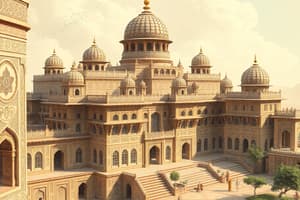Podcast
Questions and Answers
What was the primary purpose of the citadel in Harappan cities?
What was the primary purpose of the citadel in Harappan cities?
- To house the common people
- To protect the city from external threats
- To serve as a marketplace for trade
- To provide a residence for the ruling class and elite (correct)
What was unique about the construction of buildings in Harappan cities?
What was unique about the construction of buildings in Harappan cities?
- They were constructed with a sophisticated system of weights and measures (correct)
- They were built using a combination of stone and wood
- They were built using locally-sourced materials
- They were designed to withstand natural disasters
What was a key feature of the city of Mohenjo-Daro's water management system?
What was a key feature of the city of Mohenjo-Daro's water management system?
- A system of reservoirs and aqueducts
- A sophisticated system of underground pipes
- A complex network of wells, baths, and drains (correct)
- A complex network of canals and dams
What was the purpose of the system of standardized weights and measures in Harappan trade?
What was the purpose of the system of standardized weights and measures in Harappan trade?
What was the primary mode of transportation used by the Harappans for trade?
What was the primary mode of transportation used by the Harappans for trade?
Which of the following was NOT a trade good exchanged by the Harappans?
Which of the following was NOT a trade good exchanged by the Harappans?
What was the significance of the Harappan writing system in trade?
What was the significance of the Harappan writing system in trade?
What was the geographical extent of the Harappan trade network?
What was the geographical extent of the Harappan trade network?
What was the primary material used in the construction of Harappan cities?
What was the primary material used in the construction of Harappan cities?
Study Notes
Urban Planning
- The Harappan civilization is known for its advanced urban planning, with well-designed cities that were built using baked bricks.
- Cities were divided into two parts: the citadel and the lower town.
- The citadel was the upper part of the city, where the ruling class and elite lived.
- The lower town was the lower part of the city, where the common people lived.
- Cities had advanced drainage systems, with clay pipes that carried waste away from the city.
- Buildings were constructed with a sophisticated system of weights and measures, with standard-sized bricks used throughout the city.
- The city of Mohenjo-Daro had a sophisticated water management system, with a complex network of wells, baths, and drains.
Trade Networks
- The Harappan civilization had an extensive trade network that stretched from the Indus Valley to Mesopotamia and Egypt.
- Trade goods included:
- Cotton and linen textiles
- Spices, such as pepper and cinnamon
- Semi-precious stones, such as carnelian and lapis lazuli
- Metals, such as copper, bronze, and gold
- Timber, such as cedar and ebony
- The Harappans used boats to trade with other civilizations, with evidence of shipbuilding and navigation found at the port city of Lothal.
- Trade was facilitated by a system of standardized weights and measures, which allowed for easy exchange of goods.
- The Harappans also had a system of writing, which was used to record trade transactions and other business dealings.
Urban Planning
- Harappan cities were built using baked bricks and featured advanced urban planning, with a clear division into two parts: the citadel (upper part) for the ruling class and elite, and the lower town (lower part) for common people.
- Cities had sophisticated drainage systems, utilizing clay pipes to carry waste away from the city.
- Buildings were constructed with a standardized system of weights and measures, featuring standard-sized bricks used throughout the city.
- Mohenjo-Daro, a prominent Harappan city, had a complex water management system, comprising a network of wells, baths, and drains.
Trade Networks
- The Harappan civilization had an extensive trade network that spanned from the Indus Valley to Mesopotamia and Egypt.
- Trade goods included a variety of commodities, such as:
- Cotton and linen textiles
- Spices (e.g., pepper and cinnamon)
- Semi-precious stones (e.g., carnelian and lapis lazuli)
- Metals (e.g., copper, bronze, and gold)
- Timber (e.g., cedar and ebony)
- The Harappans used boats for trade, with evidence of shipbuilding and navigation found at the port city of Lothal.
- A system of standardized weights and measures facilitated trade, enabling easy exchange of goods.
- The Harappans also had a system of writing, which was utilized to record trade transactions and other business dealings.
Studying That Suits You
Use AI to generate personalized quizzes and flashcards to suit your learning preferences.
Description
Explore the advanced urban planning of the Harappan civilization, including city divisions, drainage systems, and architecture. Learn about the social hierarchy and infrastructure of these ancient cities.




